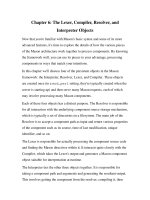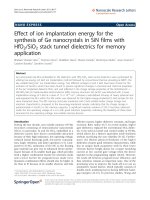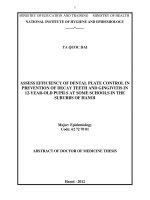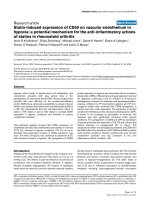Functionalization of primary C-H bonds in methylazaarenes with 3-substituted nitrobenzenes for the synthesis of 2-pyridylbenzothiazoles
Bạn đang xem bản rút gọn của tài liệu. Xem và tải ngay bản đầy đủ của tài liệu tại đây (1.5 MB, 95 trang )
ACKNOWLEDGEMENT
This thesis marks the final stage of my endeavor in conquering the Bachelor
degree in Chemical Engineering at Ho Chi Minh city University of Technology, which
I have been desperately struggling for throughout my youth. For the first chapter of my
thesis, I would like to extend my deep gratitude to people who devoted themselves to a
certain extent to help me complete my undergraduate thesis as well as myself.
I would like to express my special gratitude to Prof. Dr. Phan Thanh Son Nam,
who gave me a valuable chance to work in his laboratory, motivated me by his passion
and wide knowledge and provided me vital facilities to accomplish my thesis.
I would also like to express my gratitude to my supervisor, Dr. Nguyen Thanh
Tung, for giving me a lot of crucial advices and important feedbacks to enhance my
B.Eng thesis.
I deeply thank to Mr. Tran Minh Khoa, M. Sc. To Anh Tuong for teaching me a
lot about chemistry knowledge, and giving me a lot of advices during my thesis.
Special thanks to my co-worker, Nguyen Le Hoang Kim and Ms. Pham Thuy Hang
and my colleagues in the laboratory for helping me complete this thesis.
Finally, I would like to express my sincere gratitude to my family. Their
unconditional love and encouragement have always been with me in every
achievement I get in my life.
Ho Chi Minh City, July 2020
Do Quoc Duy
1
INTRODUCTION
Recently, the organic compounds containing sulfur elements have caught some
attention from scientist all over the world due to their important biological and
chemical properties. Benzothiazole appeared first time in 1860 as a class of
organosulfur has become popular since then. Its heterocycle skeleton bearing a 5membered ring thiazole has been observed by scientist to be an ideal source of core
scaffolds and capping fragments for the design and synthesis of target molecules on a
reasonable time scale. The investigation of these molecules enables the medicinal
chemist to rapidly discover biologically active compound in many fields of
therapeutic. Moreover, nitrogen- and sulfur- containing heterocycles also plays an
important role in many industrial fields related to special and fine chemistry. These
applications ignite an interest in developing many methods for synthesizing
compounds that wield benzothiazole functional skeleton.
2-pyridylbenzothiazole is a derivative of benzothiazoles family, and also has a lot
of applications in pharmaceutical field and industrial field. However, besides its
useful in many fields of life, benzothiazole still seems not to receive enough attention
that it deserves. There are not so many methods developed for synthesizing these
helpful compounds. Two traditional methods to synthesis benzothiazole from
aminothiophenols and thioamides had many advantages, however a lot of drawbacks
still exists. Most of the drawbacks were related to atom-, step- and redox efficiency of
the reaction. Thus, to develop a new, simple technique for preparing and enhancing the
variety of application from 2-pyridylbenzothiazole, the thesis “Functionalization of
primary C-H bonds in methylazaarenes with 3-substituted nitrobenzenes for the
synthesis of 2-pyridylbenzothiazoles” was carried out. In this work, the optimized
condition of this reaction and the scope of 2-pyridylbenzothiazoles derivatives were
investigated.
2
ABSTRACT
Synthesis of benzothiazoles often requires use of pre-functionalized and/or high
molecular weight starting materials, thus raising concerns from the viewpoints of atom
efficiencies and practicability. Herein, we report a method for preparation of
benzothiazoles from 3-substituted nitroarenes, methylazaarenes and elemental sulfur.
The transformation readily proceeded in the presence of 1,4-diazabicyclo[2,2,2]octane
(DABCO) base without the need of any solvents. Our work has attempted to study the
scope and limitation of the reaction, including compatibility of substituents on both
nitroarenes compound and methylazaarenes. Our method would offer prominent
benefits compared to conventional method since (1) stable, abundant 3-substituted
nitroarenes is utilized as nitrogen source instead of thiophenol or thioamides; (2)
simple, cheap elemental sulfur is used as redox moderator and building block agent;
(3) the conditions do not involve the presence of any metals or solvents.
3
CONTENTS
4
LIST OF SCHEMES
Different factors that influence the synthesis from N,N-dimethyl-3-nitroaniline, 2picoline and sulfur to 2-pyridylbenzothiazole……………………..….41
Scheme 3.2: DMSO used as solvent in benzothiazole synthesis reaction……………45
Scheme 3.3: Acetonitrile used as solvent in 2-arylbenzimidazoles synthesis
reaction……………………………………………………………………………….45
Scheme 3.4: 1,4-dioxane used as solvent in bezothiazoles synthesis reaction via an
intramolecular C-S bond formation…………………………………………………...46
Scheme 3.5: The final condition of reaction………………………………………….51
5
LIST OF FIGURES
LIST OF ABBREVIATIONS
Ar
Aromatics
DABCO
1,4-Diazabicyclo[2.2.2]octane
DME
Dimethoxyethane
DMF
Dimethylformamide
DMSO
Dimethylsulfoxide
DPE
Diphenyl Ether
FID
Flame ionization detector
GC
Gas chromatography
GC-MS
Gas chromatography coupled with mass spectrometry
LR
Lawesson’s Reagent
MBTU
Methabenthiazuron
MW
Microwave
NMR
Nuclear magnetic resonance
NMP
N-Methyl-2-pyrrolidone
TLC
Thin layer chromatography
TBAI
Tetrabutylammonium iodide
6
Literature review
CHAPTER 1: LITERATURE REVIEW
1.1. ELEMENTAL SULFUR IN ORGANIC SYNTHESIS
1.1.1. General introduction
Sulfur is the tenth most common element by mass in the universe, and the fifth
most common on Earth. It was first discovered by Ancient Greeks and called sulfur
theion, a word that persists in several sulfur-containing compounds. Many of which
begin with the prefix “thio-“, including the class of compounds called thiazol.
Sulfur can be found in all over the world. Especially in native and volcanic
deposits, where it is founded with abundant reserve. Though sometimes found in
native and pure form, sulfur on Earth usually occurs as sulfide and sulfate minerals [1].
Those native sulfur from underground can be extracted using Frasch process, which
was the only commercialized industrial method of recovering elemental sulfur until the
late 20th century. Moreover, sulfur also appears as an undesirable compound for any
processes related to fossil fuel due to hydrogen sulfide, which is produced during
crude processing. Sour crude oils which possess a high percentage of hydrogen sulfide
are often required extra expenses for treating refinery [2]. Today, sulfur obtained and
recovered from refining industry accounts for 98% of world elemental sulfur
production.
In history, sulfur has been used in production of black gunpowder, vulcanization
of rubber, and other synthesis of sulfur-containing compounds. Many years have
passed, and we have come to better understand about this compound, also discover
new properties of elemental sulfur, which can be efficient in application of organic
synthesis. In addition, sulfur in elemental form is not expensive and readily material,
which make sulfur becoming one of the good choices for synthetic organic chemistry.
Sulfur forms a number of polyatomic molecules, which the most popular is
cyclo-S8. The S8 molecule is the best well-known form, also being most interested in
the field of research. The pure sulfur is non-polar, so it is insoluble in water but
dissolves well in variety of organic solvents. When dissolved in polar solvents such as
7
Literature review
methanol or acetonitrile, even at room temperature, S 8 is partially transformed to S6
and S7 and attains an equilibrium in which about 1% of the sulfur is present as the
smaller rings [3]. When we heat the elemental sulfur, an S-S bond homolytic scission
phenomenon occurs, which results in sulfur being melted into an amber yellow, mobile
liquid. Eventually, this occurs at 120oC. Moreover, 95% of sulfur in liquid sulfur is in
the S8 form. As such, chemical reactions occur from over 120 oC to 160oC on basis of
S8 molecules.
1.1.2. Elemental sulfur in organic synthesis
In this part, we will go through the chemical properties of Sulfur, especially those
are applied in organic chemistry.
1.1.2.1.
Sulfur as oxidant agent
Elemental sulfur has been used as an oxidant in various reactions. In 2009,
Shihabara et al. successfully conducted an oxidative condensation-cyclization of
benzaldehydes and aryl-2-pyridylmethylamines with the presence of elemental sulfur
as a mild oxidant [4]. The reaction did not use any kind of catalyst and resulted in a
variety of Imidazo [1,5-] pyridines in high yields (Scheme 1.1).
Scheme 1.1: Oxidative condensation-cyclization of aryl-2-pyridylmethylamines and
aldehydes using elemental sulfur as an oxidant
Loskutov reported that at room temperature, anthrone and sulfur reacted
smoothly, with the presence of nitrogen nucleophiles such as aniline and hydrazine
derivatives, which results in 10-iminoanthraquinones and anthraquinones [5] (Scheme
1.2).
8
Literature review
Scheme 1.2: Reaction between Anthrone and Sulfur
Reaction to form benzimidazole, starting with sulfuration of tri-n-propylamine
into thioamide, which lately reacted subsequently with o-phenylenediamine resulted in
the desire product [6] (Scheme 1.3).
Scheme 1.3: Synthesis benzimidazole from tri-n-propylamine and sulfur
1.2.2.2. Sulfur as reductant agent
2,4-Diarylpyrroles can be synthesized in excellent yields by heating a mixture of
a 4-nitro-1,3-diarylbutan-1-one, ammonium acetate and sulfur in morpholine [7]
(Scheme 1.4).
Scheme 1.4: 2,4-diarylpyrroles can be formed using elemental sulfur as a reduction
A plausible mechanistic explanation for the formation of pyrrole was suggested
with the reduction of the nitro group of the starting butyrophenone by sulfur into
hydrazone via aci-nitro tautomer (Scheme 1.5).
9
Literature review
Scheme 1.5: Proposed mechanism for 2,4-diarylpyrroles synthesis
The next steps could be transamination starting with ammonia (in the ammonium
acetate form) with hydroxylamine as leaving nucleophile and simultaneous cyclization
to afford the expected pyrrole. Figure below illustrates some selected example
products synthesized by this method (Scheme 1.6).
Scheme 1.6: Some selected example products synthesized by this method
With the presence of a weak inorganic base NaHCO 3 in DMF, sulfur may be used
to reduce selectively nitroarenes to the corresponding anilines [8] (Scheme 1.7).
Nitrile, chloro and ester groups were not affected.
Scheme 1.7: Using sulfur to reduce nitroarenes to the corresponding anilines
1.2.2.3. Sulfur as catalyst
Sulfur in stoichiometric amounts was found to catalyze the reaction between an
aromatic nitrile ArCN and ethanolamine to provide the corresponding dihydrooxazoles
in good yield [9] (Scheme 1.8).
Scheme 1.8: Synthesis of dihydrooxazole using sulfur as a catalyst
10
Literature review
Scheme 1.9: Some selected example products synthesized by this method
With the presence of CO (high pressure) and H 2O, sulfur acts as the catalyst for
reduction reaction of β-(2-nitrophenyl)-α,β-unsaturated ketones to form corresponding
quinolines [7] (Scheme 1.10).
Scheme 1.10: Synthesis quinolines using sulfur catalyst
The active reducing agent we used here was hydrogen sulfide, which is generated
from the hydrolysis of carbonyl sulfide. At high temperature, carbonyl sulfide is
readily available by the addition of sulfur to carbon monoxide. The nitro substrate was
reduced into aniline, which underwent subsequently a cyclization-dehydration
sequence to reach quinoline product (Scheme 1.11).
Scheme 1.11: Proposed mechanism for quinoline synthesis
Scheme 1.12: Some selected example products synthesized by this method
A catalytic system consists of sulfur elemental, Net3 in the ionic liquid Bmin-BF4
was developed for reductive reaction of Nitrobenzene, ArNO 2 and its corresponding
aniline ArNH2. The reaction occurs under high pressure of carbon monoxide
11
Literature review
conditions, which provide symmetrical N,N’-diarylureas in high yield (up to 96%) [8]
(Scheme 1.13).
Scheme 1.13: Synthesis N.N’-diarylureas, using sulfur catalyst
1.2.2.4. Sulfur as building block – sulfuration reaction
a) Reaction with formation of heterocycles:
When heating at 78oC the mixture of anthraquinones and elemental sulfur in an
ethanolic alkaline solution, we can achieve the corresponding thienoanthraquinone
adducts, which also in the high yields [10] (Scheme 1.14).
Scheme 1.14: Synthesis of thienoanthraquinone using catalyst as the building block
Scheme 1.15: Applied in the reaction of the chlorinated derivatives 23’.
2– Substituted benzothophenes could be prepared in moderate yields, with
starting materials is -substituted 2-bromo--methoxystyrenes. This is a two-step
reaction. The first step consisted in a sulfur incorporation by treatment of lithiated
derivatives with elemental sulfur. The second one is the cyclization sequence of the
12
Literature review
resulting methoxy-2-sulfanylstyrenes, which was conducted at room temperature with
concentrated HI in acetonitrile [11] (Scheme 1.16).
Scheme 1.16: Synthesis of benzothophenes using sulfur as the building block
Scheme 1.17: Some selected example products synthesized by this method
With the presence of atmospheric O 2/KI/DMSO system, N-arylphenothiazines
were achieved through reactions between anilines and cyclohexanone [12] (Scheme
1.18).
Scheme 1.18: Synthesis of N-arylphenothiazines using sulfur as the building block
There is also report about synthesis 1,2-Dithiole. The 1,2-Dithiole was
synthesized by the reaction of acetodithioacetates at 90 oC, under the presence of
element Sulfur and InCl3. However, it is not clear how many sulfur atoms from
elemental sulfur were incorporated into products [13] (Scheme 1.19). Figure illustrates
some selected example products synthesized by this method.
13
Literature review
Scheme 1.19: Synthesis of 1,2-Dithiole by using sulfur
Scheme 1.20: Some selected example products synthesized by this method
1,2,3-Thiadiazole motifs can be synthesized from N-tosylhydrazones and sulfur
via the TBAI-catalyzed reaction. Products of this reaction are intermediates of
synthetic processes [14] (Scheme 1.21).
Scheme 1.21: Synthesis of 1,2,3-Thiadiazole motifs by using sulfur
b) Reactions without formation of sulfa-heterocycles
In the presence of elemental sulfur, benzylamine can be able to react to form Nbenzylthiobenzamide via 2 intermediate reactions: oxidation into imine NH’ –
transimination to imine even at 1000C. The process of the transformation of
benzylamines into thiobenzamides proceeded faster under microwave conditions
(Scheme 1.22).
14
Literature review
Scheme 1.22: Transformation of benzylamines into thiobenzamides
Scheme 1.23: Synthesis of thioamide by using elemental sulfur
Primaryalkil halides (1a-c) (and sulfonates 35d) were rapidly converted to their
corresponding dialkyl disulfides 36a-d. This reaction occurs under solvent-free
conditions with the presence of sulfur, NaBH 4 as a reducing agent and neutral alumina
as a solid support [15] (Scheme 1.24). We obtained an excellent yield at 35a.
However, the reaction is incompatible with reducible substituents such as nitro 35b or
nitrile 35c.
15
Literature review
Scheme 1.24: Synthesis of disulfides by using elemental sulfur
1.2. SYNTHESIS OF BENZOTHIAZOLE
1.2.1. Introduction
Thiazole is a 5-membered ring, which contains sulfur and nitrogen atoms. It
plays an important role in medicinal chemistry. It is also an essential core scaffold in
many types of natural vitamin and synthetic important compounds.
Benzothiazole is the name of a fused membered rings, which contain heterocycles
bearing thiazole. The presence of sulfur and nitrogen atoms are constituted the core
structure of thiazole and many pharmacologically and biologically active compounds
[16]. Benzothiazole consists of a 5-membered 1,3-thiazole ring, attached to a benzene
ring. All nine atoms of the bicycle and the attached substituents are coplanar [17]
(Figure 1.1).
Figure 1.1: Thiazole (I) and benzothiazole (II)
16
Literature review
In 1887, 2-substituted benzothiazole was first synthesized by A. W. Hofmann
[18]. In the mid-19th century, 2-aminobenzothiazoles were studied as central muscle
relaxants. Since then, medicinal chemists have lost interest in this chemical family not
until Riluzole was discovered [19]. Riluzole (6-trifluromethoxy-2-benzothiazloamine)
was discovered for experiments purpose. It has an ability to interfere with glutamate
neurotransmission in biochemical, electrophysiological biphasic and behavioral
experiments. Since then, benzothiazoles and its derivatives have gained popularity
again in pharmaceutical fields. Although benzothiazoles have been successfully
applied in a short interval of time, the range of their application is very broad.
1.2.1.1.
Biological applications of benzothiazole derivatives
A review of recent literature revealed that a heterocyclic moiety was appeared in
the structure of many antimicrobial agents [20], in particular, benzothiazole derivatives
has received special attention since they belong to a medicinal chemical family with
proven utility. Because of its valuable scaffold, benzothiazole possesses diverse
biological activities, such as anticancer [21], antimicrobial [22], anticonvulsant [23],
anti-inflammatory [24], antiviral [25] and antimalarial [26] effects. In the
pharmaceutical market nowadays, benzothiazole also appeared as core nucleus in
various drugs, all due to their diverse biological activities, e.g. viozan (dual D2
dopamine receptor, 2-adrenoceptor agonist), probenazole (herbicide), riluzole,
ethoxazolamide (carbonic anhydrase inhibitor, etc) (Figure 1.2)
17
Literature review
Figure 1.2: Marketed drugs containing benzothiazole moiety
a) Anticancer activity
Osmaniye et al. in 2018 has successfully synthesized new 2-((5-substitutedbenzothiazole-2-yl)thio)-N’-(2-(4-substituted-phenylethylidence)acetohydrazide
derivatives 1 and evaluated their anticancer activity against A549, C6, MCF-7 and HT29 cells [27]. Novel benzothiazole-based non-sulfamide NAE (NEDD8 activating
enzyme) inhibitors 2a-c, which were discovered by Zhuang et al. in 2017, also proved
that their potential in antitumor activity with IC 50 values in nanomolar range [28].
Berberine-benzothiazole conjugates synthesized by Mistry et al. also proved their
abilities in fighting against HeLa, CaSki (cervical cancer) and SK-OV-3 (ovarian
cancer) 3a-b (Figure 1.3).
18
Literature review
Figure 1.3: Anticancer activity of benzothiazole derivatives
b) Antimicrobial activity
In 2018, Haroun et al. successfully synthesized 2-(6-methoxybenzo[d]thiazole-2ylimino)-5-benzyliden-thiazolidin-4-one derivatives 4, which were then evaluated for
antimicrobial activity. The results found that almost all compounds exhibited about 217 better than the reference drugs ampicillin [29]. Quinoline-based benzothiazolyl1,2,4-triazole 5a-b are synthesized and screened for antimicrobial activity by Peter
and Park [30]. Compound 5a exhibited potent activity against Gram-positive bacteria
Staphylococcus aureus while compound 5b was effective against Gram positive
bacteria B. cereus. (Figure 1.4)
19
Literature review
Figure 1.4: Antimicrobial activity of benzothiazole derivatives
c) Anticonvulsant activity
Siddiqui et al. have successfully synthesized a series of 2-[(6-substitutedbenzo[d]thiazol-2-ylcarbamoyl)methyl]-1-(4-substituted-phenyl)isothiourea
derivatives as anticonvulsant agents. In those derivatives, two compound 6a and 6b
exhibited as most active compounds in comparison with the standard drug: phenytoin
and carbamazepine [31]. Another study of benzothiazoles about anticonvulsant was
studied by Liu et al. in 2016 [32]. Among the benzothiazole derivatives, compound 7
was found to be most effective comparing to standard drugs (carbamazepine) in
anticonvulsant assay. Liu et al. also reported the synthesis of a new anticonvulsant
series of 7-alkoxy[1,2,4]triazolo[3,4-b]benzothiazole-3(2H)-ones [33]. Among those
derivatives, two derivatives 7-propoxy[1,2,4]triazolo[3,4-b]benzothiazole-3(2H)-one
8a and 7-butoxy[1,2,4]triazolo[3,4-b]benzothiazole-3(2H)-one 8b showed highest
activity against maximal electroshock-induced toxic extensions, in comparison to
carbamazepine (Figure 1.5).
20
Literature review
Figure 1.5: anticonvulsant activity of benzothiazole derivatives
d) Antimalarial activity
Thakkar et al. have successfully synthesized a novel series of benzothiazole
analogues, and compounds 9a and 9b were found to be most active in antimalarial
activity test [34]. While Sharma et al. synthesized a new series of N-(6-methobenzo[d]thiazole-2-yl)-2-substituted
phenyl-1H-benz[d]imidazole-1-carbothioamide
derivatives. The compound substituted with (3,4,5-trimethoxy) 10a and with (3,4dinitro) 10b shows high inhibition against P.falciparum when compare to reference
drug chloroquine [35]. A series of amodiaquine analogues of benzothiazole 11a-c were
synthesized by Ongarora et al. These compounds could block the formation of toxic
quinone imine and aldehyde metabolites without affecting antiplasmodial activity
(Figure 1.6).
21
Literature review
Figure 1.6: Antimalarial activity of benzothiazole derivatives
e) Anti-inflammatory
Tariq et al. have synthesized N-[3-(Substituted-4H-1,2,4-triazol-4-yl)]benzo[d]
-thiazol-2-amines [36]. The compounds then were screened for anti-inflammatory
activity. According to result, compounds 12 was found to be most active when
compare to reference drug diclofenac sodium. After that, Tariq et al. continued
investigated further and synthesized N-(benzothiazole-2-yl)-2-[(5-(phenoxymethyl)-422
Literature review
aryl-4H-1,2,4-triazol-3-yl)thio]acetamide derivatives [37]. Among all derivatives,
compound 13 exhibited to be the most active compound in anti-inflammatory activity
(Figure 1.7).
Figure 1.7: Anti-inflammatory activity of benzothiazole derivatives
1.2.1.2.
Industrial applications of benzothiazole derivatives
Being heterocyclic compounds, Benzothiazole derivatives are also famous for
various fields of chemical research, for instance, industrial applications. Some are
known as intermediates for dies [38], plant protectants [39], and photographic
sensitizers.
Benzothiazole salts have been applied in photographic for a long time. Since
1989, C. R. Messing has invented a new way to stabilize photographic recording
material with respect to reducing or to eliminating chemical fog formation during film
storage [40]. He employed a combination of mercury compound and benzothiazolium
in the film materials (Figure 1.8).
23
Literature review
Figure 1.8: Typical examples of benzothiazolium compounds which can be used in
combination with mercury salts in film materials
2-substituted benzothiazoles are also contributes to plant protectants industry.
Benzothiazole itself is a fungicide [41]. Methabenthiazuron (MBTU) is used as
herbicide in winter corn crops, slimicides in the paper and pulp industry [42]. On the
other hand, 2-aminobenzothiazole is used in disperse azo dye manufacture
industry[43] (Figure 1.9).
Figure 1.9: Benzothiazole derivatives' industrial applications
1.2.2. Conventional methods
Because of their extremely crucial functionality in the field of medical science
and organic chemistry, benzothiazole has gathered interests from many scientists
around the world. It leaded to a variety of methods for preparation of the
24
Literature review
benzothiazole’s framework. Among of that, there are two traditionally well-known
methods: condensation reaction of 2-aminothiophenols and Jacobson’s cyclization of
thiobenzanilides.
1.2.2.1. Condensation reaction of 2-Aminothiophenols
The pioneer method was condensation of aminothiophenol with the substituted
nitriles, aldehydes, carboxylic acids, acyl chloride or esters. 2-aminothiophenol is an
oxygen sensitive compound, so it easily forms derivatives such as acid salts, alkaline
salts or disulfides, which results in allowing them to react with a number of reagents
[44]. Early examples of 2-arylbenzothiazole syntheses that are still valuable today
involve the condensation of 2-aminothiophenol with a benzoic acid or related
derivatives by heating in a high boiling solvent such as polyphosphoric acid [45-49]
(Scheme 1.25).
Scheme 1.25: Synthesis 2-arylbenzothiazoles from 2-aminothiophenol and benzoic
acids using polyphosphoric acid as solvent
There is another green way accessing to benzothiazole by condensation reaction
between thiophenols and carboxylic acids without using solvent. In 2006, Seijas et al.
reported that Lawesson’s reagent can be used effectively as a promoter under the
solvent-free, microwave-assisted condition, to achieving both benzoxazoles and
benzothiazoles [50]. Lawesson’s reagent was first made in 1956 and is commercially
available on the market today. It can also be easily prepared in the laboratory by
heating anisole with diphosphoruspentasulfide until the mixture of both becomes clear
and no more hydrogen sulfide is formed, the recrystallized from toluene or xylene
(Scheme 1.26). Much of the chemistry of Lawesson’s reagent is from its central
phosphorus/sulfur four-membered ring, which will break two reactive dithiophosphine
when it is heated. So that, it has been used in this way to form with carboxylic acids a
mixed anhydride, which activate carboxylic acids towards peptide bond formation [51,
25









